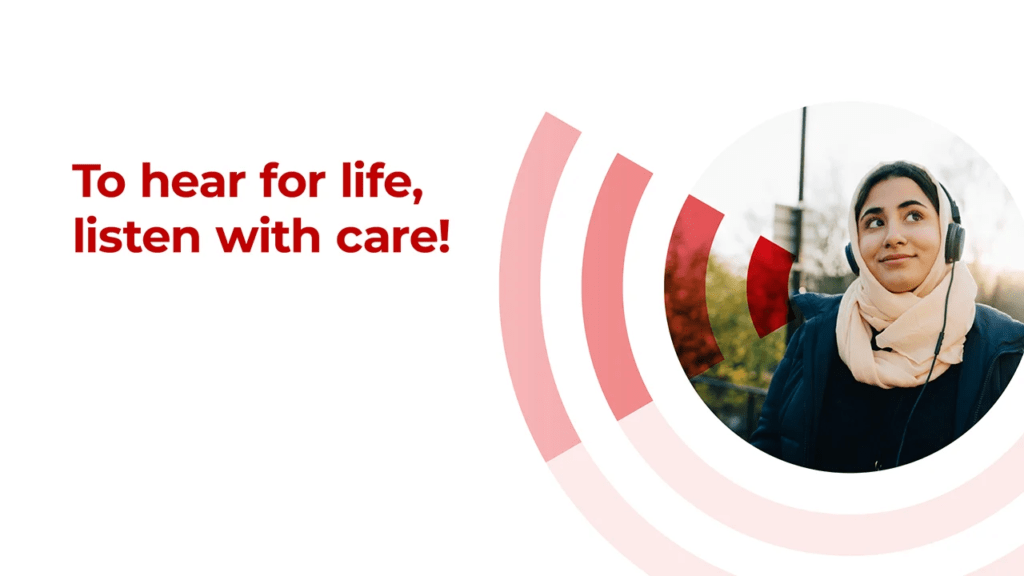In our recent infographic, we highlighted how as people start to live longer due to improving and innovative health interventions, the number of people living with hearing loss will also continue to grow. Age is only one of the many factors that can contribute to hearing loss. On World Hearing Day 2022, the focus is on a more preventable cause of hearing loss: noise exposure. This year’s theme from the World Health Organization is, “To hear for life, listen with care”.

Excessive noise exposure, whether recreational, environmental or occupational, can be harmful to hearing.1,2,3 The most common sources of noise exposure are typically through headphones, at clubs and at large music events. Many causes of hearing loss, including hearing loss due to noise, are preventable – either through individual changes or public health interventions.4 Fortunately, many countries and organizations in Europe and around the world have put measures in place to try and make listening safe. Countries like Switzerland have maximum noise exposure limits at music concerts and offer all attendees the option of ear plugs (which block out harmful noise but still allow you to enjoy the music).5 Companies like Apple have implemented headphone notifications that let you know when you’ve been listening to music at levels that are too loud for too long.
Hearing loss due to noise is irreversible, but it is also completely preventable. According to the World Health Organization, 1 in 2 young people are at risk of hearing loss due to unsafe listening habits. Small, individual changes to listening habits can also have a positive impact on healthy hearing. Some of these include:
- Taking regular breaks in a quiet area when you’re in a noisy environment.
- Limiting daily earphone use.
- Being conscious of the volume levels on your devices.
- Using noise-cancelling headphones when you’re in areas with loud noise.
There are many free apps and websites available that allow you to monitor your own hearing, such as hearWHO. Some early signs of hearing loss due to noise exposure could include continuous ringing in your ears and struggling to hear high pitched sounds. In these cases, it is best to consult a hearing specialist and intervene early.
Do you already have a hearing loss?
Almost 1 in 5 people experience some degree of hearing loss.6 This can be caused by factors other than noise and can range from a mild to a profound hearing loss. The extent to which hearing loss impacts people’s lives depends on whether it is addressed with effective clinical or rehabilitative interventions.7 For people with a more severe hearing loss, a cochlear implant (CI) has shown to provide improvements in speech perception and quality of life.8,9
However, some users experience greater speech perception benefits, with their CI than others. Currently, we can only explain around 25% of what causes this difference in speech perception outcomes. Within the MOSAICS project, we aim to better understand, identify, and intervene on the variability in outcomes among adult CI users by adopting a novel multidisciplinary approach. Ultimately, we hope to achieve life-long hearing for everyone. Read more about our 4 MOSAICS Early-Stage Researchers and how their research is addressing the outcome variability of CI users.
Check out our MOSAICS Twitter account where we’ll be sharing more facts around hearing loss due to noise exposure and tips around healthy listening habits.
References
- Kraaijenga VJ, Ramakers GG, Grolman W. (2016). The effect of earplugs in preventing hearing loss from recreational noise exposure: a systematic review. JAMA Otolaryngol Head Neck Surg. 142(4):389–94.
- Śliwińska-Kowalska M, Zaborowski K. (2017). WHO environmental noise guidelines for the European Region: a systematic review on environmental noise and permanent hearing loss and tinnitus. Int J Environ Res Public Health. 14(10):1139.
- Lie A, Skogstad M, Johannessen HA, Tynes T, Mehlum IS, Nordby K-C, et al. (2016). Occupational noise exposure and hearing: a systematic review. Int Arch Occup Environ Health. 89(3):351–72.
- World Health Organization. (2021). World Report on Hearing. ISBN: 9789240020481.
- World Health Organization. (2015). Make listening safe. Department for Management of NCDs; Disability, Violence and Injury Prevention (NVI).
- Haile et al. (2021). Hearing loss prevalence and years lived with disability, 1990–2019: findings from the Global Burden of Disease Study 2019. The Lancet. DOI: 10.1016/S0140-6736(21)00516-X.
- Wilson et al. (2017). Global hearing health care: new findings and perspectives. The Lancet. DOI: 10.1016/S0140-6736(17)31073-5
- Gaylor et al. (2013). Cochlear Implantation in Adults: A Systematic Review and Meta-analysis. JAMA. DOI: 10.1001/jamaoto.2013.1744
- Boisvert et al. (2020). Cochlear implantation outcomes in adults: A scoping review. PlosOne. DOI: 10.1371/journal.pone.0232421
